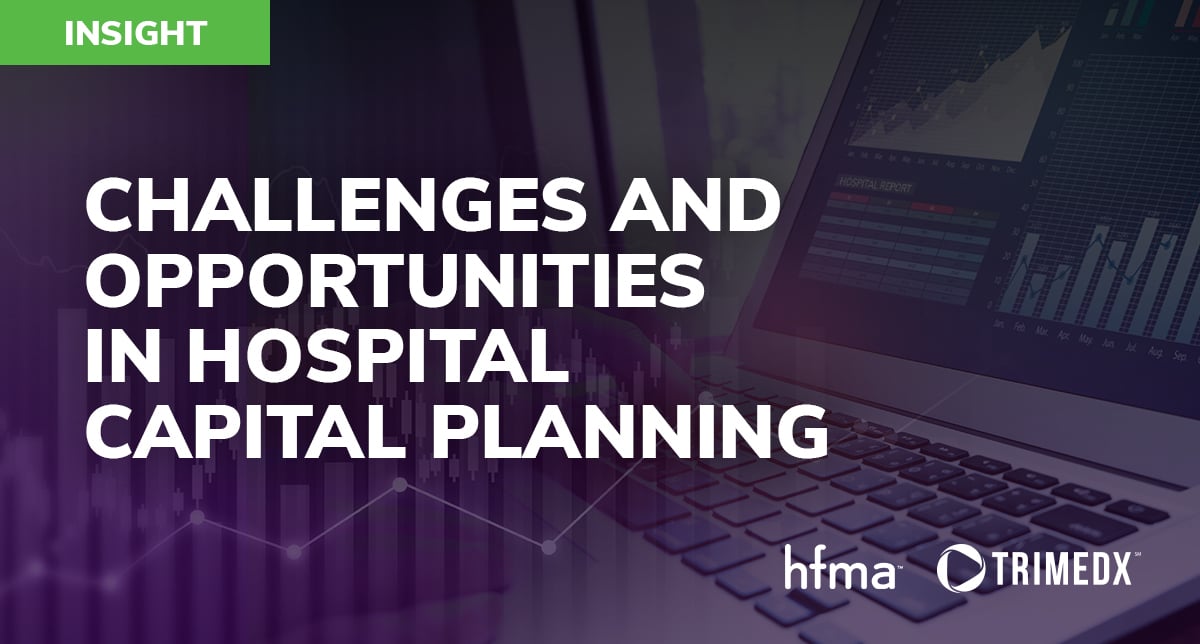The financial health of American health systems is one of the most pressing matters in the industry. Many hospitals’ operating margins have shrunk to dire lows in recent years. In response, financial decision-makers in healthcare organizations have begun to look at major expenses and investments with much greater scrutiny. At the same time, the nation’s demand for health care only increases. Patient care is integral to the mission of healthcare providers, and the needs of patient populations further compound the complexity of hospital capital planning.
An HFMA Annual Conference Roundtable brought healthcare leaders together to discuss learnings from and strategies for clinical asset management. The panelists tackled the challenging questions that come with simultaneously managing community needs with financial hurdles.
Crucial lessons learned from the pandemic
The COVID-19 pandemic accelerated some healthcare industry shifts while complicating how health systems could respond to others. A major outcome was the delay of hospitals’ capital planning initiatives. Deferring these major expenses, along with programs like COVID-19 Accelerated and Advance Payments (CAAP) from CMS and CARES Act funds, helped hospitals bolster their financial health at a crucial time.
Without funding to invest in additional resources and equipment, health system leaders needed to find new ways to rise to unexpected challenges. A common challenge that these health systems dealt with was an imbalance between their available resources and patient volumes. The roundtable panelists cited examples ranging from ICU beds and ventilators to staffing. Previously planned capital expenditures could have helped to alleviate some of these imbalances, but the pandemic demanded flexibility and creative solutions.
One example cited was the stockpiling of critical resources like ventilators, as implemented across the state of New York. The main intent was to centralize resources and allocate them to the care sites with the greatest need. A similar concept could also be executed on a smaller scale, within the network of a single health system. A panelist representing a health system in the Washington, D.C., metro area explained how centralized dashboards listing available equipment made these resources more accessible to hospitals. Reallocation within the network proved to be a valuable tool where new purchases were not possible.
Rethinking what capital planning looks like in the future
The takeaways that healthcare leaders drew from the pandemic will prove useful far beyond global crises. Panelists recognized that cost-cutting by itself will not create a path to financial security for health systems. Simply reducing budgets amid modern healthcare trends can easily run counter to prioritizing care delivery if not planned and executed carefully. Health systems are continuing to consolidate over larger geographic areas to produce economies of scale. Yet these mergers and the operation of the resulting larger networks come with their own unique costs.
At the same time, the areas requiring capital planning considerations are growing, not shrinking. Healthcare IT is rapidly transforming into a focus for strategic investment. The impact of technology and data management on patient safety has become impossible to ignore. Even as health systems pursue a sense of normalcy following the pandemic, emerging priorities require a new balance.
Panelists elaborated on increased levels of scrutiny during the hospital capital asset planning process. Some had shifted to a process involving clinical departments presenting their requests, after which leadership would vote to allocate funding based on the merits of the presentations. Posing very direct questions such as “Is this purchase revenue-generating?” or “What is the consequence of not making this investment?” was another example of setting a high bar for securing capital funds.
In these cases of increased scrutiny in securing capital expenses, creative solutions from the pandemic offer a new path forward. Panelists reported finding opportunities to use current medical device inventories to fill needs not funded by capital expenses. This tactic offered a two-fold benefit of deferring capital purchases while also increasing the useful life and the realized value of current equipment.
An untapped area of potential for financial efficiency
Throughout the pandemic and its aftermath, healthcare leaders and clinicians have shown incredible resiliency and flexibility to continue caring for patients. As health systems look toward pursuing their long-term goals, these experiences can offer tremendous value. Panelists identified bond issuance as a major avenue for funding growth and new ventures, with debt reduction as a subsequent priority. In many of these cases, reallocating existing assets such as medical devices were not viewed as a component of the health systems’ financial strategies and remained an unrealized opportunity.
When striving to balance preserving patient care with financial needs, clinical asset reallocation presents a prime opportunity to amplify the value of past investments while controlling costs. Information sharing proved to be a vital resource for health systems to execute this strategy, both during and beyond the pandemic. One panelist described the centralization of supply chain and procurement processes, which increased the ability to find assets for reallocation instead of new purchases.
This example highlights exactly how valuable reallocation can be. In a time where capital budgets are constrained and supply costs are rising rapidly, health systems can look internally for solutions that may never have been considered before. Hospital capital asset planning can be much more than yes or no answers to new purchase requests. With strategic clinical asset reallocation, the question becomes how many opportunities can be found to increase the value for health systems and their patients.
